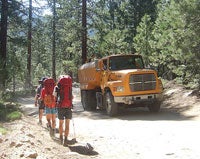National Parks Go Green

It’s no surprise that the effects of climate change are hitting national parks—more frequent flooding, receding glaciers, and slight temperature changes that effect plants and animals. Frustrated rangers are discovering that along with mammoth SUV’s and puffing smoke stacks, they too are to blame for their own troubles.
Just how much greenhouse gases are national parks spewing into the air? The three Washington parks of Mt. Rainier, North Cascades, and Olympic are estimated to have a combined carbon footprint of 30,820 metric tons of carbon monoxide. Not only does that sound like a lot, it is a lot—a year’s worth of emissions from 2,667 houses.
Although the idea of an environmentally unhealthy Park Service may seem ironic, it actually makes a great deal of sense. More than 5 million visitors drive to the three parks and leave behind mountains of plastic bottles and wrappers. Rangers that drive across the combined 1.85 million acres are behind the wheels of huge, heavy-duty pickup trucks. Warming and lighting bathrooms and visitor centers consumes thousands of dollars worth of energy each year.
So what’s an outdoor service to do when they find out they’re contributing to the destruction of the lands it’s their duty to protect? The Park Service has accelerated the greening process with a goal to become completely carbon-neutral in the western region by 2016, just in time for their 100th anniversary.
It’s a lofty goal to be sure, but they’ve already started reducing their footprint by employing solar and wind energy in park bathrooms and using smaller trucks with detachable trailers. They have a long way to go, but it’s a good start.
Other national parks are dealing with similar problems, such as the haze over Big Bend. Have you noticed climate change or human impacts effecting your local national park? Vent in the comments section below.
—Morgan Keys
National parks seek to reduce carbon footprint of workers, visitors (Miami Herald)
Image credit: wetwebwork (via Flickr)